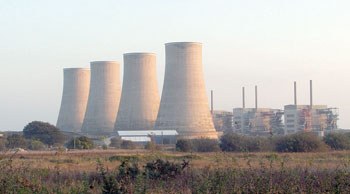As we were saying, that, Nuclear Fission and all the interplanetary energy that the word “nuclear” invokes, power plants that depend on atomic energy don’t operate that differently from a typical coal-burning power plant. Both heat water into pressurized steam, which drives a turbine generator.The underlying factors that induce fission that nuclear power plants require, Uranium is the one most important element to the production of both nuclear power and nuclear bombs.


As we were saying, that, Nuclear Fission and all the interplanetary energy that the word "nuclear” invokes, power plants that depend on atomic energy don’t operate that differently from a typical coal-burning power plant.
Both heat water into pressurized steam, which drives a turbine generator. The underlying factors that induce fission that nuclear power plants require, Uranium is the one most important element to the production of both nuclear power and nuclear bombs.
U-235 decays naturally by alpha radiation: It throws off an alpha particle, or two neutrons and two protons bound together.
It’s also one of the few elements that can undergo induced fission.
Fire a free neutron into a U-235 nucleus and the nucleus will absorb the neutron, become unstable and split immediately.
As soon as the nucleus captures the neutron, it splits into two lighter atoms and throws off two or three new neutrons (the number of ejected neutrons depends on how the U-235 atom splits).
The process of capturing the neutron and splitting happens very quickly.
The decay of a single U-235 atom releases approximately 200 MeV (million electron volts).
That may not seem like much, but there are lots (millions) of uranium atoms in kilograms of uranium. So many, in fact, that a kilogram of highly enriched uranium as used to power a nuclear submarine is equal to about four million litres of petrol.
Imagine if it was used to drive a car, 1 kg of enriched uranium could drive a 4000CC Jeep for nearly 3 years at a rate of 100kms per day! This is quite a tempting analysis!
The splitting of an atom releases an incredible amount of heat and gamma radiation, made of high-energy photons. The two atoms that result from the fission later release beta radiation (superfast electrons) and gamma radiation of their own, too.
But for all of this to work, scientists have to first enrich a sample of uranium so that it contains 2 to 3 percent more U-235. Three-percent enrichment is sufficient for nuclear power plants, but weapons-grade uranium is composed of at least 90 percent U-235.
In order to turn nuclear fission into electrical energy, nuclear power plant operators have to control the energy given off by the enriched uranium and allow it to heat water into steam. It is this steam that turns the turbines in the production of Electricity.
Enriched uranium typically is formed into inch-long pellets, each with approximately the same diameter as a coin.
Next, the pellets are arranged into long rods, and the rods are collected together into bundles.
The bundles are submerged in water inside a pressure vessel.The water acts as a coolant.
Left to its own devices, the uranium would eventually overheat and melt.
To prevent overheating, control rods made of a material that absorbs neutrons are inserted into the uranium bundle using a mechanism that can raise or lower them.
Raising and lowering the control rods allow operators to control the rate of the nuclear reaction.
When an operator wants the uranium core to produce more heat, the control rods are lifted out of the uranium bundle (thus absorbing fewer neutrons).
To reduce heat, they are lowered into the uranium bundle. The rods can also be lowered completely into the uranium bundle to shut the reactor down in the event of an accident or to change the fuel.
(To be Cont’d)


